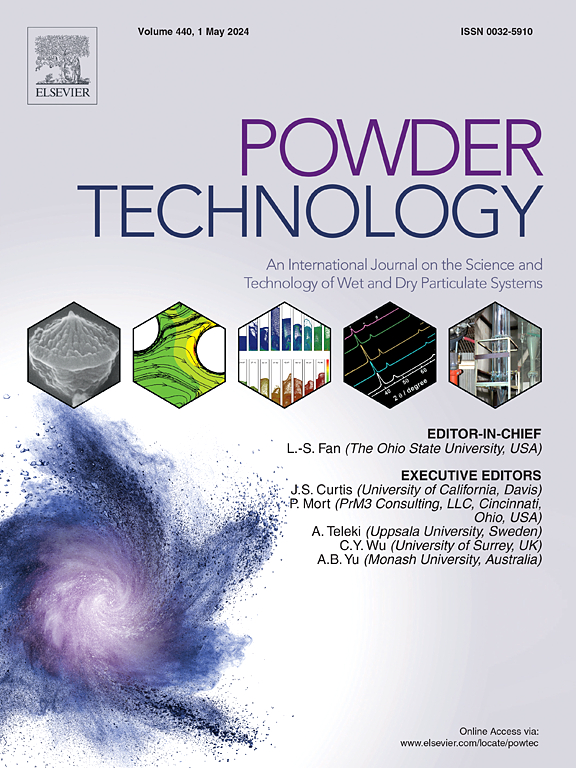A novel coarse-grained discrete element method for simulating failure process of strongly bonded particle materials
IF 4.5
2区 工程技术
Q2 ENGINEERING, CHEMICAL
引用次数: 0
Abstract
Strongly bonded particle materials are widely used in energy engineering, geotechnical engineering and other fields. However, there is still a lack of an effective approach for large-scale DEM simulation of strongly bonded particle materials with low computational cost. To address the excessive computational cost in large-scale DEM simulation of strongly bonded particle materials, this study proposes a coarse-grained method based on energy density conservation principle, comprehensively incorporating multiple energy forms, including elastic strain energy, damping dissipation energy, and rolling friction energy. Scaling relations of microscopic parameters in the coarse-grained system are derived to ensure the conservation of all forms of energy density mappings within the spring and damping elements during the particle scaling process. Numerical simulations were performed on both cylindrical specimens and single-perforated plate models under loading compression using the developed coarse-grained method. Results demonstrate that the coarse-grained system accurately reproduces the key physical parameters of the original system, including failure modes, damage characteristics, energy density, and mechanical properties. In contrast, simulations without coarse-grained system exhibited significantly higher errors, with magnitudes ranging from several tens up to 130 times greater than those of the coarse-grained system, thus validating the accuracy and effectiveness of the proposed method.

一种新的模拟强粘结颗粒材料破坏过程的粗粒度离散元方法
强粘结颗粒材料广泛应用于能源工程、岩土工程等领域。然而,对于强结合颗粒材料的大规模DEM模拟,目前还缺乏一种有效的低计算成本方法。针对强结合颗粒材料大尺度DEM模拟计算成本过高的问题,本研究提出了基于能量密度守恒原理的粗粒度方法,综合考虑弹性应变能、阻尼耗散能、滚动摩擦能等多种能量形式。推导了粗粒度系统中微观参数的标度关系,以保证在颗粒标度过程中弹簧和阻尼元件内部各种形式的能量密度映射的守恒。采用所建立的粗粒度方法对圆柱试件和单孔板模型进行了加载压缩的数值模拟。结果表明,粗粒度体系能够准确再现原体系的关键物理参数,包括失效模式、损伤特征、能量密度和力学性能。相比之下,没有粗粒度系统的模拟显示出明显更高的误差,其幅度从粗粒度系统的几十倍到130倍不等,从而验证了所提出方法的准确性和有效性。
本文章由计算机程序翻译,如有差异,请以英文原文为准。
求助全文
约1分钟内获得全文
求助全文
来源期刊

Powder Technology
工程技术-工程:化工
CiteScore
9.90
自引率
15.40%
发文量
1047
审稿时长
46 days
期刊介绍:
Powder Technology is an International Journal on the Science and Technology of Wet and Dry Particulate Systems. Powder Technology publishes papers on all aspects of the formation of particles and their characterisation and on the study of systems containing particulate solids. No limitation is imposed on the size of the particles, which may range from nanometre scale, as in pigments or aerosols, to that of mined or quarried materials. The following list of topics is not intended to be comprehensive, but rather to indicate typical subjects which fall within the scope of the journal's interests:
Formation and synthesis of particles by precipitation and other methods.
Modification of particles by agglomeration, coating, comminution and attrition.
Characterisation of the size, shape, surface area, pore structure and strength of particles and agglomerates (including the origins and effects of inter particle forces).
Packing, failure, flow and permeability of assemblies of particles.
Particle-particle interactions and suspension rheology.
Handling and processing operations such as slurry flow, fluidization, pneumatic conveying.
Interactions between particles and their environment, including delivery of particulate products to the body.
Applications of particle technology in production of pharmaceuticals, chemicals, foods, pigments, structural, and functional materials and in environmental and energy related matters.
For materials-oriented contributions we are looking for articles revealing the effect of particle/powder characteristics (size, morphology and composition, in that order) on material performance or functionality and, ideally, comparison to any industrial standard.
 求助内容:
求助内容: 应助结果提醒方式:
应助结果提醒方式:


